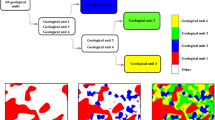Abstract
Geostatistical simulation methods aim to represent spatial uncertainty through realizations that reflect a certain geological concept by means of a spatial continuity model. Most common spatial continuity models are either variogram, training image, or Boolean based. In this paper, a more recent spatial model of geological continuity is developed, termed the event, or surface-based model, which is specifically applicable to modeling cases with complex stratigraphy, such as in sedimentary systems. These methods rely on a rule-based stacking of events, which are mathematically represented by two-dimensional thickness variations over the domain, where positive thickness is associated with deposition and negative thickness with erosion. Although it has been demonstrated that the surface-based models accurately represent the geological variation present in complex layered systems, they are more difficult to constrain to hard and soft data as is typically required of practical geostatistical techniques. In this paper, we develop a practical methodology for constraining such models to hard data from wells and thickness data interpreted from geophysics, such as seismic data. Our iterative methodology relies on a decomposition of the parameter optimization problem into smaller, manageable problems that are solved sequentially. We demonstrate this method on a real case study of a turbidite sedimentary basin.













Similar content being viewed by others
References
Abrahamsen P, Fjellvoll B, Hauge R, Aas T (2007) Process based stochastic modeling of deep marine reservoirs. Paper presented at EAGE petroleum geostatistics, Cascias, Portugal
Biver P, D’Or D, Walgenwitz A (2008) Random genetic simulation of lobes: internal architecture construction and gridding. Paper presented at AAPG international conference and exhibition, Cape Town
Caers J (2011) Modeling uncertainty in the Earth sciences. Wiley, New York
Charvin K, Gallagher K, Hampson GL, Labourdette R (2009) A Bayesian approach to inverse modelling of stratigraphy, part 1: Method. Basin Res. 21(1):5–25
Cojan I, Fouche O, Lopez S, Rivoirard J (2005) Process-based reservoir modelling in the example of meandering channel, In: Leuangthong O, Deutsch C (eds) Geostatistics Banff. Springer, Berlin, pp 611–619
Hu L (2000) Gradual deformation and iterative calibration of Gaussian-related stochastic models. Math Geol 32(1):87–108
Jenson SK, Domingue JO (1988) Extracting topographic structure from digital elevation data for geographic information system analysis. Photogramm Eng Remote Sens 54(11):1593–1600
Journel A (2002) Combining knowledge from diverse sources: an alternative to traditional data independence hypotheses. Math Geol 34(5):573–596
Lesshafft L, Meiburg E, Kneller B, Marsden A (2011) Towards inverse modeling of turbidity currents: the inverse lock-exchange problem. Comput Geosci 37(4):521–529
Mariethoz G, Renard P, Froidevaux R (2009) Integrating collocated auxiliary parameters in geostatistical simulations using joint probability distributions and probability aggregation. Water Resour Res 45(8):1–13
Michael H, Boucher A, Sun T, Caers J, Gorelick S (2010) Combining geologic-process models and geostatistics for conditional simulation of 3-D subsurface heterogeneity. Water Resour Res 46 (W05527)
Miller J, Sun H, Stewart C, Genty D, Li D, Lyttle C (2008) Direct modeling of reservoirs through forward process based models: can we get there? Paper presented at international petroleum technology conference, Kuala Lumpur, Malaysia
Nelder A, Mead R (1965) A simplex method for function minimization. Comput J 7(4):308–313
Pyrcz M, Deutsch C (2004) Stochastic modeling of inclined heterolithic stratification with the bank retreat model. Paper presented at CSPG/CWLS/CHOA joint convention, Calgary, Alberta
Pyrcz M, Strebelle S (2006) Event-based geostatistical modeling of deepwater systems. Paper presented at 26th annual Gulf Coast section SEPM conference, Houston
Pyrcz M, Boisvert J, Deutsch C (2009) ALLUVSIM: a program for event-based stochastic modeling of fluvial depositional systems. Comput Geosci 35(8):1671–1685
Pyrcz MJ, Catuneanu O, Deutsch CV (2005) Stochastic surface-based modeling of turbidite lobes. Am Assoc Pet Geol Bull 89(2):177–191
Pyrcz M, Clark J, Drinkwater N, Sullivan M, Fildani A, McHargue T (2006) Event-based models as a quantitative laboratory for testing quantitative rules associated with deepwater distributary lobes. Paper presented at reservoir characterization: integrating technology and business practices: Gulf Coast section-SEPM twenty-sixth annual research conference
Saller A, Werner K, Sugiaman F, Cebastiant A, May R, Glenn D, Barker C (2008) Characteristics of Pleistocene deep-water fan lobes and their application to an upper Miocene reservoir model, offshore East Kalimantan, Indonesia. Am Assoc Pet Geol Bull 92(7):919–949
Scheidt C, Caers J (2009) Uncertainty quantification in reservoir performance using distances and kernel methods—application to a West Africa deepwater turbidite reservoir. SPE J 14(4):680–692
Stright L (2006) Modeling, upscaling, and history matching thin, irregularly-shaped flow barriers: a comprehensive approach for predicting reservoir connectivity
Sylvester Z, Pirmez C, Cantelli A (2011) A model of submarine channel-levee evolution based on channel trajectories: implications for stratigraphic architecture. Mar Petroleum Geol 28(3):716–727
Thore P, Shtuka A, Lecour M, Ait-Ettajer T, Cognot R (2002) Structural uncertainties: determination, management, and applications. Geophysics 67(3):840–852
Xie Y, Deutsch C (2000) Surface geometry and trend modeling for integration of stratigraphic data in reservoir models. Paper presented at sixth international geostatistics congress, Cape Town
Zhang X, Pyrcz MJ, Deutsch CV (2009) Stochastic surface modeling of deepwater depositional systems for improved reservoir models. J Pet Sci Eng 68(1–2):118–134
Acknowledgements
We would like to acknowledge the donation of data by ExxonMobil.
Author information
Authors and Affiliations
Corresponding author
Rights and permissions
About this article
Cite this article
Bertoncello, A., Sun, T., Li, H. et al. Conditioning Surface-Based Geological Models to Well and Thickness Data. Math Geosci 45, 873–893 (2013). https://doi.org/10.1007/s11004-013-9455-4
Received:
Accepted:
Published:
Issue Date:
DOI: https://doi.org/10.1007/s11004-013-9455-4




